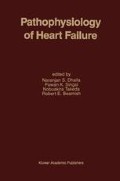Abstract
Paradoxical and even beneficial effects of diabetes mellitus on the circulation system have been noted by several authors [1–3]. We found that diabetic hearts are more tolerant to high-frequency pacing [4] and that isolated, perfused diabetic rat hearts are less susceptible to ischemia—reperfusion injury in the substrate-free condition [5].
Access this chapter
Tax calculation will be finalised at checkout
Purchases are for personal use only
Preview
Unable to display preview. Download preview PDF.
Refereces
Tani M, Neely JR. 1988. Hearts from diabetic rats are more resistant to in vivo ischemia: possible role of altered Ca2+ metabolism. Circ Res 62:931–940.
Kusama Y, Hearse DJ, Avkiran M. 1992. Diabetes and susceptibility to reperfusion-induced ventricular arrhythmias. J Mol Cell Cardiol 24:411–421.
Khandoudi N, Bernard M, Cozzone P, Feuvrey D. 1990. Intracellular pH and role of Na+/H+ exchange during ischemia and reperfusion of normal and diabetic rat hearts. Cardiovasc Res 24:873–878.
Mochizuki S, Ozeki T, Tanaka F, Nagano M. 1991. Regulation of substrate utilization and ventricular function in diabetic hearts. In Nagano M, Dhalla NS (eds.), The Diabetic Heart. Raven Press: New York, pp. 351–364.
Mochizuki S, Tanaka F. Ejima M, Onodera T, Taniguchi M, Nagano M. 1994. Attenuation of susceptibility to ischemia/reperfusion in isolated, substrate free perfused hearts from diabetic rats. In Nagano M, Takeda N, Dhalla NS (eds.), The Adapted Heart. Raven Press: New York, pp. 423–429.
Neely JR, Liebermeister H, Battersby EJ, Morgan HE. 1967. Effect of pressure development of oxygen consumption by isolated rat heart. Am J Physiol 212:804–814.
Neely JR, Rovetto MJ, Whitmer JT, Morgan HE. 1973. Effect of ischemia on function and metabolism of isolated working rat heart. Am J Physiol 225:651–658.
Harris AS, Bisteni A, Russell RA, Brigham JC, Firestone JE. 1954. Excitatory factors in ventricular tachycardia resulting from myocardial ischemia. Potassium a major excitant. Science 119:200–203.
Hill JL, Gettes LS. 1980. Effect of acute coronary occlusion on local myocardial extracellular K+ activity in swine. Circulation 61:768–778.
Pierce GN, Dhalla NS. 1983. Sarcolemmal Na+/K+-ATPase activity in diabetic rat heart. Am J Physiol 245:C241–C247.
Heyliger CE, Prakash A, McNeil JH. 1987. Alterations in cardiac sarcolemmal Ca2+ pump activity during diabetes mellitus. Am J Physiol 252:H540–H544.
Case RB. 1971/72. Ion alterations during myocardial ischemia. Cardiology 56:245–262.
Weiss JN, Shieh R. 1994. Potassium loss during myocardial ischaemia and hypoxia: does lactate efflux play a role? Cardiovasc Res 28:1125–1132.
Kantor PF, Coetzee WA, Carmeliet EE, Dennis SC, Opie LH. 1990. Reduction of ischemic K+ loss and arrhythmias in rat hearrts. Effect of glibenclamide, a sulfonylurea. Circ Res 66:478–485.
Noma A. 1983. ATP-regulated K+ channels in cardiac muscle. Nature 305:147–148.
Grover GJ. 1994. Protective effects of ATP sensitive potassium channel openers in models of myocardial ischemia. Cardiovasc Res 28:778–782.
Gross GJ, Auchampach JA. 1992. Role of ATP-dependent potassium channels in myocardial ischaemia. Cardiovasc Res 26:1011–1016.
Antzelevitch C, DiDiego JM. 1992. Role of K+ channel activators in cardiac electrophy-siology and arrhythmias. Circulation 85:1627–1629.
Cole WC, McPherson CD, Sontag D. 1991. ATP-regulated K+ channels protect the myocardium against ischemia/reperfusion damage. Circ Res 69:571–581.
Sargent CA, Smith MA, Dzwonczyk S, Sleph PG, Grover GJ. 1991. Effect of potassium channel blockade on the anti-ischemic actions of mechanistically diverse agents. J Pharmacol Exp Ther 259:97–103.
Fosset M, De Weille JR, Green RD, Schmid-Antomarchi H, Lazdunski M. 1988. Antidiabetic sulfonylureas control action potential properties in heart cells via high affinity receptors that are linked to ATP-dependent K+ channels. J Biol Chem 263:7933–7936.
Bekheit SS, Restive M, Boutjdir M, Henkin R, Gooyanden K, Assadi M, Khatib S, Gough WB, El-Sherif N. 1990. Effects of glyburide on ischemia-induced changes in extracellular potassium and local myocardial activation: a potential new approach to the management of ischemia-induced malignant ventricular arrhythmias. Am Heart J 119:1025–1033.
Wollenben CD, Sanguinetti MC, Siegl PKS. 1989. Influence of ATP-sensitive potassium channel modulators in ischemia-induced fibrillation in isolated rat hearts. J Mol Cell Cardiol 21:783–788.
Cacciapouti F, Speizia R, Bianchi U, Lama D, D’Avino M, Varricchio M. 1991. Effectiveness of glibenclamide on myocardial ischemic ventricular arrhythmias in non-insulin-dependent diabetes mellitus. Am J Cardiol 67:843–847.
Davies NW, Standem NB, Stanfield PR. 1992. The effect of intracellular pH on ATP-dependent potassium channels of frog skeletal muscle. J Physiol 445:549–568.
Davies NW. 1990. Modulation of ATP-sensitive K+ channels in skeletal muscle by intracellular protons. Nature 343:375–377.
Cuevas J, Bassett AL, Cameron JS, Furukawa T, Myerburg RT, Kimura S. 1991. Effect of H+ on ATP-regulated K+ channel in feline ventricular myocytes. Am J Physiol 261:H755-H761.
Fan Z, Makielski JC. 1993. Intracellular H+ and Ca2+ modulation of tripsin-modified ATP-sensitive K+ channels in rabbit.ventricular myocytes. Circ Res 72:715–722.
Lederer WJ, Nichols CG. 1989. Nucleotide modulation of the activity of rat heart ATP-sensitive K+ channels in isolated membrane patches. J Physiol 419:193–211.
Anderson SE, Murphy E, Steenbergen C, London RE, Cala PM. 1990. Na-H exchange in myocardium: effects of hypoxia and acidification on Na and Ca. Am J Physiol 259:C940–C948.
Murphy E, Perlman M, London RE, Steenbergen C. 1991. Amiloride delays the ischemia-induced rise in cytoslic free calcium. Circ Res 68:1250–1258.
Mochizuki S, Seki S, Ejima M, Onodera T, Taniguchi M, Ishikawa S. 1993. Na+/H+ exchanger and reperfusion-induced ventricular arrhythmias in isolated perfused heart: possible role of amiloride. Mol Cell Biochem 119:151–157.
Pierce GN, Philipson KD. 1985. Na+-H+ exchange in cardiac sarcolemmal vesicles. Biochim Biophys Acta 818:109–116.
Luzdunski M, Freiin C, Vigne P. 1985. The sodium/hydrogen exchange in cardiac cells: its biochemical and pharmacological properties and its role in regulating internal concentrations of sodium and internal pH. J Mol Cell Cardiol 17:1029–1042.
Editor information
Editors and Affiliations
Rights and permissions
Copyright information
© 1996 Kluwer Academic Publishers
About this chapter
Cite this chapter
Mochizuki, S. et al. (1996). Diabetic State Reduces Ischemic K+ Loss and H+ Efflux in Isolated Rat Hearts. In: Dhalla, N.S., Singal, P.K., Takeda, N., Beamish, R.E. (eds) Pathophysiology of Heart Failure. Developments in Cardiovascular Medicine, vol 168. Springer, Boston, MA. https://doi.org/10.1007/978-1-4613-1235-2_29
Download citation
DOI: https://doi.org/10.1007/978-1-4613-1235-2_29
Publisher Name: Springer, Boston, MA
Print ISBN: 978-1-4612-8525-0
Online ISBN: 978-1-4613-1235-2
eBook Packages: Springer Book Archive

